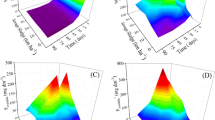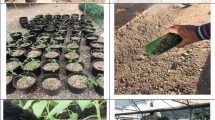Abstract
A field experiment was conducted to study the impact of irradiated and non-irradiated sewage sludge applied to sandy soil on the productivity of fennel plants (Foeniculum vulgare L.). Four rates of irradiated and non-irradiated sewage sludge application were used (20, 40, 60, and 80 t ha−1). Samples analysis included the biomass production at the vegetative and flowering stages, seed production, volatile oil content, volatile oil constituents, chlorophyll content, total and reducing sugars, and the heavy metals content of the shoots and seeds.
The biomass production increased as the sludge application rate increased for both irradiated and non-irradiated plots. However, the increase was significantly higher under all irradiated treatments than the corresponding rates of non-irradiated treatments at both the vegetative and flowering stages. At the vegetative stage, the biomass values ranged from 10.2 to 34.1 g plant−1 at 80 t ha−1 for non-irradiated and irradiated sewage sludge, respectively. Whereas at the flowering stage, the values ranged from 23.9 to 65.1 g plant−1 at 80 t ha−1 for non-irradiated and irradiated sewage sludge, respectively. Total sugars, reducing sugar, non-reducing sugar and chlorophyll content increased as the sludge application rate increased. At the 80 t ha−1 of irradiated sludge application rate, the reducing sugar content was 29.39 mg g−1 DW (dry weight) at the vegetative stage and 37.85 mg g−1 DW at the flowering stage. Regarding heavy metals, sewage sludge was a good source to provide fennel plants with essential micronutrients (Zn and Fe) in the meantime, the translocation of (Pb and Cd) to the shoot system was very low. A linear gradual increase in seed yield was observed as the sludge application rate increased. Irradiated sewage sludge treatments showed a higher fennel seed yield than non-irradiated sewage sludge treatments.
Volatile oil percentages exhibited no observable variations due to the use of sewage sludge. A few and limited fluctuations could be observed. However, total oil content (l ha−1) increased due to the increase in seed yield. The magnitude of increase in volatile oil production in response to the sewage sludge application was parallel to the increase in seed yield. The GLC measurements of the fennel volatile oil reveal that the t-anethole is the predominant fraction. However, fenchone was detected in a relatively moderate concentration. The applied sewage sludge treatment induced some variations in fennel volatile oil constituents. The t-anethole is relatively higher in volatile oil obtained from plants grown on sandy soil fertilized with non-irradiated sewage sludge than that fertilized with irradiated sewage sludge. In the meantime, the increase in t-anethole was accompanied by a decline in fenchone content. Under all sludge application rates iron and zinc concentrations of fennel seeds were within the normal plant concentration range, whereas there were only traces of Cd concentration.




Similar content being viewed by others
References
Abo El-Seoud MA, Abd El-Sabour MF, Omer EA (1997) Productivity of roselle (Hibiscus sabdariffa L.) plant as affected by organic waste composts addition to sandy soil. Bull Nat Res Cent Egypt 22:493–503
Abo-El-Seoud M, El-Motaium RA, Bataresh M, Kreuzig R (2004) Impact of gamma radiation on the degradability of polynuclear aromatic hydrocarbons in egyptian sewage sludge. Fresen Environ Bull 13(1):52–55
Ahmed YKM (1991) Biochemical and physiological studies on some aromatic plants. M.Sc. Thesis, Faculty of Agriculture, Cairo University
AOAC (1980) Official methods of the Association of Official Analytical Chemists. Association of Official Analytical Chemists, Washington, DC
Arslan N, Bayrak A, Akgul A (1989) The yield and components of essential oil in fennels of different origin grown in Ankara conditions. Herba Hungarica 28:27–31
Ashraf M, Bhatty MK (1975) Studies on the essential oils of the Pakistani species of the family Umbelliferae. II. Foeniculum Yulgare Miller (fennel) seed oil. Pak J Sci Ind Res 18:236–240
Badawy SH, El-Motaium RA (1999) Effect of irradiated and non-irradiated sewage sludge application on some nutrients heavy metals content of soils and tomato plants. Proceedings of the 1st Congress on: Recent Technologies in Agriculture. Bull Fac Agric, Cairo University, Special Edition, vol. IV, pp 728–744
Bauer R (1994) Application of solar radiation for photochemical wastewater treatment. Chemosphere 29:1225–1228
Bundesgesundheitsamt (1986) Richtwerte ‘86 fur Blei, Cadmium und Quecksilber in und auf Lebensmitteln. Bundesgesundhbl 29:22–23
Chaney RL (1983) Potential effects of waste constituents on the food chain. In: Parr JF, Marsh PB, Kla JM (eds) Land treatment of hazardous wastes. Noyes Data Corporation, Park Ridge, NJ, pp 152–240
Donald JL (1972) Trace metals in soils, plants and animals. Adv Agron 24:267–325
Dubois M, Smith F, Gilles KA, Hamilton JK, Robers PA (1956) Colorimetric method for determination of sugars and related substances. Anal Chem 28(3):350–356
El-Khawas KH (1995) Influence of certain radiation on the chemical composition of some species. Ph.D. Thesis, Faculty of Agriculture, Cairo University
Epstein E, Taylor JM, Chaney RL (1976) Effects of biosolids and sludge compost applied to soil on some soil physical and chemical properties. J Environ Qual 5:422–426
Getoff N (1996) Radiation-induced degradation of water pollutants—state of the art. Radiat Phys Chem 47:581–593
Grant CA, Buckley WT, Bailey LD, Selles F (1998) Cadmium accumulation in crops. Can J Plant Sci 78:1–17
Guenther E (1961) The essential oils, vols III and IV, 4th edn. D. Yan Nostrand, New York
Gurdip S, Ramakrishna U, Narayanan CS, Padmkumari KP, Singh G, Upadhyay R (1990) The chemical investigation of essential oil of Foeniculum vulgare Mill. Ind Perfumer 34:247–249
Hashimoto S, Nishimura K, Kawakami W, Watanabe H (1986) Disinfection of sewage sludge cake by an electron accelerator. J Ferment Technol 64:299–304
Hornick SB, Parr JF (1987) Restoring the productivity of marginal soils with organic amendments. Am J Altern Agric 11(2):64–68
Inskeep WP, Bloom PR (1985) Extinction coefficient of chlorophyll a and b in N,N-dimethylformamide and 80% acetone. Plant Physiol 77:483–485
Jones BJ, Wolf B, Mills HA (1991) Plant analysis handbook, a practical sampling, preparation, analysis and interpretation guide. Micro-Macro, Athens, GA, p 164
Karlsen J, Baerheim SA, Chingova B, Zolatovich G (1969) Fruits of Foeniculum species and their essential oils. Planta Med 1793:281–293
Lessel TH (1988) Disinfection of sewage sludge by gamma irradiation and alternative methods. IAEA-TECDOC-454 on: technical and economic comparison of irradiation and conventional methods
Marotti M, Piccaglia R (1992) The influence of distillation conditions on the essential oil composition of three varieties of Foeniculum vulgare Mill. J Essent Oil Res 4:562–576
Marotti M, Dellacecca V, Piccaglia R, Giovanelli E, Palevitch D, Simon JE, Mathe A (1993) Agronomic and chemical evaluation of three varieties of Foeniculum vulgar Mill. First World Congress on Medicinal and Aromatic Plant for Human Welfare (WOCMAP), Maastricht, Netherlands, 19–25 July 1992. Acta Hortic 331:63–69
Marschner H (1986) Mineral nutrition of higher plants. Academic Press, London
Merrill EW (1977) Destruction of trace toxic compounds in water and sludge by ionizing radiation. Reproduced from the M.I.T. Report to NSF “High Energy Electron Radiation of Wastewater Liquid Residuals”, December, 1977, and “Water 1977” AICHE Symposium Series No. 178, 74:245–250
Pandya GA, Sachidanand S, Modi VV (1989) Potential of recycling gamma-irradiated sewage sludge for use as a fertilizer: a study on chickpea (Cicer arietinum). Environ Pollut 56:101–111
Rabie ME, Esaadani AM, Abdel-Sabour MF, Mousa IA (1995) The use of water hyacinth as an organic manure to amend soils. Egypt Soil Sci J 35:105–116
Ryan JA, Bryndzia LT (1998) Fate and potential effects of trace elements: issues in co-utilization of by-products. In: Brown S, Angle JS, Jacobs L (eds) Beneficial co-utilization of agricultural, municipal and industrial by-products. Kluwer, Dordrecht, pp 219–233
Scora RW, Chang AC (1997) Essential oil quality and heavy metals concentrations of peppermint grown on a municipal sludge-amended soil. J Environ Qual 26:975–979
Susplugas P, Mongold JJ, Carnat AP, Camillieri S, Masse JP, Taillade C, Serrano JJ (1991) Diuretic properties of a lyophilized extract of Foeniculum vulgare. Plantes Med Phytother 25:163–169
United States Environmental Protection Agency (1993) 40 CFR part 257 et al., Standards for the use or disposal of sewage sludge; final rules. Fed Reg 58(32):9248–9415
Vogtmann H, Fricke K (1989) Nutrient value and utilization of biogenic composts in plant production. Agric Ecosyst Environ 27:471–475
Acknowledgement
The authors wish to thank the International Atomic Energy Agency (Vienna, Austria) for the help and support provided through the TC Project (EGY/8/014).
Author information
Authors and Affiliations
Corresponding author
Rights and permissions
About this article
Cite this article
El-Motaium, R.A., El-Seoud, M.A.A. Irradiated sewage sludge for production of fennel plants in sandy soil. Nutr Cycl Agroecosyst 78, 133–142 (2007). https://doi.org/10.1007/s10705-006-9079-x
Received:
Accepted:
Published:
Issue Date:
DOI: https://doi.org/10.1007/s10705-006-9079-x




